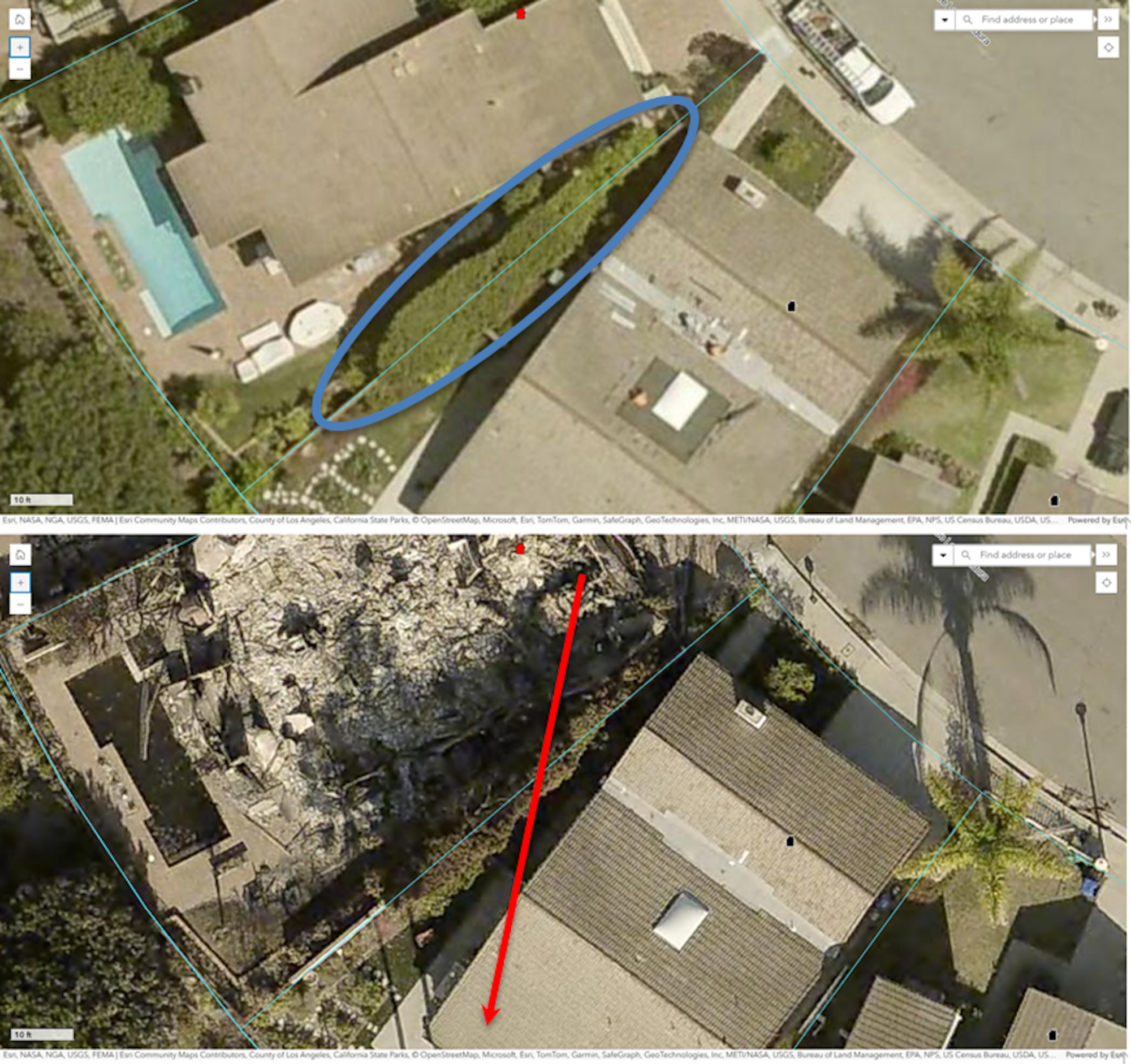One of the placing patterns within the aftermath of many city fires is how a lot unburned inexperienced vegetation stays amid the wreckage of burned neighborhoods.
In some circumstances, a row of shrubs could also be all that separates a surviving home from one which burned just some ft away.
As scientists who examine how vegetation ignites and burns, we aren’t shocked by these photos: We acknowledge that well-maintained vegetation and bushes will help shield properties from wind-blown embers and gradual the unfold of fireplace in some circumstances. So we’re involved about new wildfire safety rules being developed by California that will prohibit virtually all vegetation and different flamable materials inside 5 ft of properties, an space referred to as “Zone 0.”
If that prohibition stays within the ultimate regulation, it’s prone to be met with public resistance. Getting these guidelines proper additionally issues past California, as a result of rules that originate right here usually ripple outward to different fire-prone areas.
Analysis into how vegetation can cut back fireplace threat is a comparatively new space of examine. Nevertheless, the findings from plant flammability research, in addition to examination of web sites the place vegetation and houses survive giant city fires, spotlight its significance.
When surviving vegetation seem scorched after these fires, it’s usually on the aspect of the plant dealing with a close-by construction that burned. That implies that wind-blown embers ignited homes first: The homes had been then the gas as the hearth unfold by the neighborhood.
Photographs earlier than and after the 2025 Palisades fireplace present thick inexperienced vegetation between two intently spaced properties. The arrow exhibits the course of the hearth’s unfold. When surviving vegetation seem scorched after these fires, it’s usually on the aspect of the plant dealing with a close-by construction that burned. That implies that wind-blown embers ignited homes first: The homes had been then the gas as the hearth unfold by the neighborhood.
(Max Moritz; Cal Fireplace harm inspection photographs)
We noticed this repeatedly within the Los Angeles space after wildfires destroyed hundreds of properties in January. The sample suggests a have to concentrate on the various components that may affect residence losses.
A number of guides can be found that specify steps householders can take to assist shield homes, significantly from wind-blown embers, referred to as residence hardening. Some examples embrace putting in rain gutter covers to maintain lifeless leaves from accumulating, avoiding flammable siding and guaranteeing that vents have screens to forestall embers from moving into the attic or crawl area.
Nevertheless, steering associated to landscaping vegetation varies vastly, and a few of it’s unhealthy recommendation.
For instance, some “fire-safe” plant lists include species which are drought tolerant however not essentially fireplace resistant. On the subject of preserving vegetation from changing into gas for fires, what issues greater than species choice is how properly vegetation is maintained and whether or not it’s correctly watered. Location issues too: Dry, unmanaged vegetation beneath home windows or close to fences could ignite quickly and make it extra doubtless that the home itself will catch fireplace.
When well-watered, residing plant materials is heated by a close-by vitality supply, reminiscent of a fireplace, the moisture inside it should be pushed off earlier than it may ignite. That evaporation cools the encircling space and lowers the plant’s flammability.
In lots of circumstances, excessive moisture retains a plant from igniting. We’ve seen this in a few of our experimental work and in different research that check the flammability of decorative landscaping.
With sufficient warmth, dried leaves and stems can break down and launch unstable gases. At that time, a close-by spark or flame can ignite these gases and set the plant on fireplace.
Even when the plant does burn, nevertheless, its moisture content material can restrict different facets of flammability, reminiscent of how sizzling it burns.
Inexperienced, well-maintained vegetation can gradual the unfold of a fireplace by serving as warmth sinks, absorbing vitality and even blocking embers. This obvious protecting function has been noticed in each Australia and California research of residence losses.
How usually vegetation buffers properties from igniting throughout city conflagrations continues to be unclear, however this capability has implications for rules.
Lots of the newest Zone 0 suggestions, reminiscent of prohibiting mulch and hooked up fences made from supplies that may burn, stem from large-scale assessments carried out by the Nationwide Institute of Requirements and Expertise and the Insurance coverage Institute for Enterprise and Residence Security. These options might be systematically analyzed.
However vegetation is much more durable to mannequin. The state’s proposed Zone 0 rules oversimplify advanced situations in actual neighborhoods and transcend what’s presently recognized from scientific analysis concerning plant flammability.
Vegetation is just not monolithic. A mature, well-pruned shrub or tree with a excessive crown could pose little threat of burning and may even cut back publicity to fires by blocking wind and warmth and intercepting embers. Aspen bushes, for instance, have been really helpful to scale back fireplace threat close to buildings or different high-value property.
As California and different states develop new wildfire rules, they should acknowledge the protecting function that well-managed vegetation can play, together with many different advantages of city vegetation.
We imagine the California proposal’s present emphasis on extremely prescriptive vegetation removing, as an alternative of on upkeep, is overly simplistic. With out complementary necessities for hardening the properties themselves, widespread clearing of landscaping instantly round properties might do little to scale back threat and will even irritate the hazard.
Max Moritz is a Cooperative Extension wildfire specialist and an adjunct professor of environmental science at UC Santa Barbara. Luca Carmignani is an assistant professor of mechanical engineering at San Diego State College. This text was produced in partnership with the Dialog.


